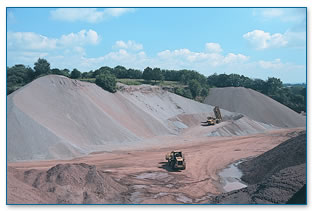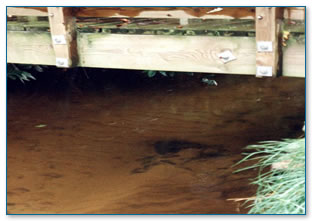industry,
rivers and waste
One way of controlling pollution
is to discharge waste into the sewage system. The problem does not
disappear entirely, but at least it goes to the sewage treatment
works where the Water Company has installed the facilities to clean
it up, before discharging it into the watercourse. Most industries
in the South West do this - the tanneries, the abattoirs, the dairy
processing plants and metal plating works.
 |
A quarry |
However, some works like paper
mills and the china clay companies discharge direct into rivers
in the Westcountry. Sewerage works themselves are also a major industry.
All these operations have strict limits agreed with the Environment
Agency on particles or chemicals etc. that they can discharge into
the river. They have systems in place that clean up and check the
water before it is discharged to make sure. In most cases the companies
do a good job in discharging good quality water. Unfortunately,
when something goes wrong these operations can be a real pollution
threat, but because they are monitored the Environment Agency is
able to punish the failure by prosecuting the offender in Court.
 |
Clean stream meets china clay contaminated
stream |
Times change and we now demand
much higher environmental standards by companies. For example, the
china clay industry historically used to discharge clay waste, made
up of very fine particles, into the rivers of mid-Cornwall. The
river that ran through St Austell was called the "White River"
because of the clay particles in it, and fish and animal life in
the river was very limited. The River Fal used to run white quite
often too, but because the levels of particles were less than in
the White River, eels and brown trout were still able to survive.
The solids (clay particles) released from this industry do not kill
or poison directly, but they limit the amount of light able to get
to the plants and creatures that live in rivers and streams, Now,
the White River and the River Fal generally run clear, and there
is much more life in the river as species are re-colonising the
river bed.
 |
In-stream habitat
smothered by sediment |
The solids also smother vegetation
and riverbeds with a fine layer of clogging silt. This alters the
habitat and interferes with the feeding of filtering animals like
freshwater mussels and blackfly larvae (B09a). In Cornwall the washings
from tin extraction at South Crofty, Camborne, contribute to the
Red River. When you’ve got a river named after a pollutant,
you’ve really arrived!
Tin mining creates another problem.
The old tunnels, or adits, create underground watercourses. As the
water level changes in them, oxidised metals are washed into nearby
rivers such as the Carnon, these include arsenic and zinc, which
are highly toxic. Problems such as this are practically non-solvable;
it is a legacy from the past that we have to live with.
 |
Heavy metal runoff |
In the sediments of rivers lie
many legacies of the way land has been used. We may not be able
to alter the way the land was used in the past, but with an eye
to the future steps can be taken to safe guard the environment for
wildlife.
Industries these days can
and do take precautions to reduce their harmful impact on the environment.
Some industries take an especially active role in doing their bit
for the environment by making sure their operations are carefully
monitored and go beyond purely meeting requirements set out by law.
For example, industries and businesses can look to gaining an ISO
14001 Accreditation.
|

